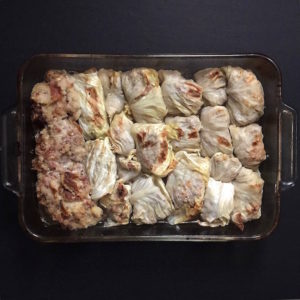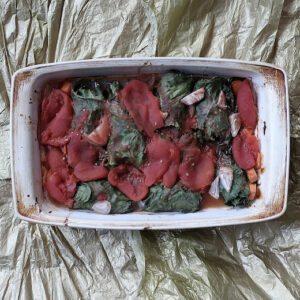Stuffed Cabbage In The Troo Style
Stuffed Cabbage In The Troô Style is a recipe I’ve longed to write about.
Yes, cabbage. With its connotations of sulfur, Soviet canteen meals, wind.
This recipe is none of those things. We love this dish. Love it. Which is why I’ve longed to write about it.
Stuffed Cabbage In The Troô Style came to my attention years ago. We belonged to a CSA program whose weekly winter deliveries were comprised of hard squash, kale, and enormous heads of cabbage. Neither of us were fond of the vegetable. As it began piling up, I grew slightly frantic and began searching for ways to use it up. Enter Stuffed Cabbage In The Troô Style, courtesy of Tamasin Day-Lewis’s Good-Tempered Food.

Tamasin Day-Lewis’s work has never quite caught on stateside. More’s the pity. Of Stuffed Cabbage In The Troô Style, she writes:
If the recipe hadn’t been Jane Grigson’s I’m pretty sure I wouldn’t have stopped, looked, and cooked; after all , what is so special about sausages and cabbage? And just how effective can the alchemy of the two be, to transmute them into something so far from what the imagination can conceive of?
Pretty high-flown prose for such pedestrian fare. But Day-Lewis is right. Adjectives like “alchemy” and “transmute” apply when heat, time, and a little fat turn an oft-despised vegetable into an aromatic, silken dish that delights with every forkful. The long, slow cooking ameliorates everything we hate about cabbage–its harsh, grassy tendencies, its indigestibility, its unpleasant cooking odors.
Before getting to the recipe, let us praise the late, great Jane Grigson. If Day-Lewis is little known in the United States, Grigson is nearly unheard of. One of the great culinary scholars, Grigson earned an English degree at Cambridge and worked as a translator before becoming an erudite culinary writer. Her learned books are engaging, warm, and welcoming. Sadly, Grigson died at only 62 from pancreatic cancer.
Although Day-Lewis credits Grigson with the recipe, she doesn’t cite which book. So when I stumbled across Stuffed Cabbage In The Troô Style in Grigson’s Vegetable Book–surely a logical place for it–I was startled. The book and I were in a Los Angeles hotel room. To my right, an enormous picture window afforded an extraordinary urban vista. Somewhere out in that brightly lit grid lay the hospital where my father-in-law had died hours earlier. At a time when everything felt upended, Grigson’s commonsense prose brought immense comfort. Happening on that recipe, one we’d enjoyed many times, was a strangely grounding experience.
Even without that oddly consoling encounter, I cannot recommend this humble dish enough. This despite the recipe going walkabout on me, the cabbage proving undersized, the sausages resolutely clinging to their casings, bad weather making for unappetizing photographs. No matter: the resulting dish was delicious. So delicious that anticipated leftovers, destined for a pre-soccer practice lunch, were rather scant.
—
As noted above, Stuffed Cabbage In The Troô Style photographs poorly, a problem in this era of “food porn.” Never have I struggled so to make a dish appear appetizing, finally resorting to the ramekins seen here. For all they may read “pretty,” this is a ridiculous serving suggestion. This is a hearty winter dish, asking to be heaped on your plate or piled it in deep bowl. Recall David Lebovitz’s observation that we eat with our mouths, not our eyes.
I served it with homemade rolls, baked from Middle Eastern Yogurt Bread–follow the bread recipe up to punching it down for the second rise. Using a knife, bench scraper, or scissors, cut or slice the bread into equally-sized rolls; I got seven pieces, to which I added a teaspoon each of fennel and cumin seeds. Roll gently in your palms to make rounded shapes. Don’t overhandle the dough. Place on baking tray and cover with oiled plastic wrap. Allow second rise of 45 minutes. Preheat oven to 400 degrees. Bake for 20 minutes. Be happy.
Make the cabbage dish with your favorite plain sausages, or mix plain sausagemeat with spicier fare, like chorizo. If you eschew pork, chicken sausage, ground chicken, or even ground beef work beautifully here. I’ve used them all.
It’s tempting to add things here. Don’t. Grigson herself writes:
I have tried it with various spicy and aromatic additions, tomatoes, bits of bacon, herbs, and so on, but reject them all in favour of the Troô simplicity of cabbage, good sausagemeat and butter. It has a pure directness that is just right and cannot be improved.
Stuffed Cabbage In The Troô Style
This recipe originally appears in Jane Grigson’s Vegetable Book. I first found it in Tamasin Day-Lewis’s Good-Tempered Food.
Yield: 2-3 servings; may easily be increased by using a larger cabbage and more sausage.
Cooking time: 90 minutes-2 hours, depending on the size of your cabbage.
1 2-pound cabbage: Dutch or Savoy
1 pound best-quality plain sausagemeat (about 4 sausages, if in skins)
butter
salt and pepper
Preheat oven to 300 degrees F.

Shred the cabbage finely into a large bowl. Both Grigson and Day-Lewis advocate blanching the cabbage in boiling water. As I live in drought country, I skip this step, and find the dish doesn’t suffer a bit.

If your sausages are in casings, remove them and crumble into a bowl. If your sausages stubbornly refuse to part from their skins, just slice thinly into coins, add to said bowl, and move on.
Wash your hands. For the next step you’ll need a 3-4 quart casserole–enameled cast iron, Pyrex, whatever. Ideally this vessel has a lid. No lid? Foil is fine.
Lightly butter the bottom of your pot.

Now make the stuffed cabbage. Make a layer of cabbage, then a layer of sausagemeat. Salt and pepper lightly. Remember your sausage may be salty.

Continue until your ingredients are used up, finishing with a layer of cabbage (or chard, in my case: see note, below).

Dot with butter, cover, and slip into the oven.

Cook 90 minutes for a smaller cabbage, up to 2 hours for a larger one. The dish is done when a spatula slices easily through the layers and cabbage is completely soft.
Day-Lewis suggests serving with mashed potato, though we find it quite the meal in itself, wanting nothing more than some bread to sop up the delicious juices. To that end, I served it with homemade rolls, baked from the Middle Eastern Yogurt Bread recipe–follow up to punching dough down for the second rise. Using a knife, bench scraper, or scissors, cut or slice the bread into equally-sized rolls; I got seven pieces, kneading in a teaspoon each fennel and cumin seeds. Roll gently in your palms to make rounded shapes. Don’t overhandle the dough. Place on baking tray and cover with oiled plastic wrap. Allow second rise of 45 minutes. Preheat oven to 400 degrees. Bake for 20 minutes. Be happy.
Leftovers reheat well in the microwave or oven.
Note: This recipe really wanted to backfire on me. Not only did the sausage cling to its skins, the cabbage was too small. I considered stopping until I could purchase fresh ingredients and start over.
And then I thought: WWJD?
Julia would have kept her wits, adding a little butter and finishing the dish. I had some chard–also a brassica happy to be cooked a long time–so I used it to bulk out the cabbage. And it worked fine. That’s what you see in the photo: a chard blankie over all, smeared with a little butter. Life is what happens when you’re making other plans.





